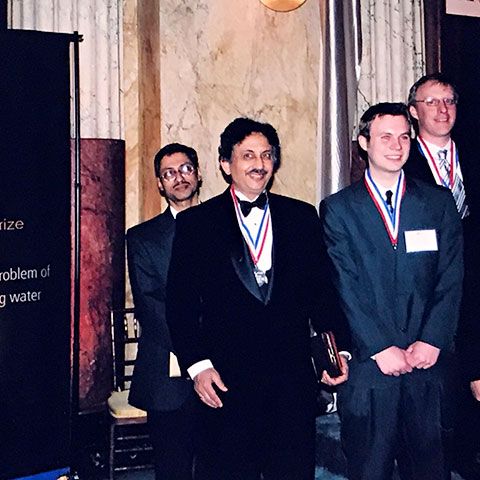Accolades abound for researcher and Lehigh environmental engineering alum
Dr. Lee Blaney ’05 ’07G has had quite a banner year in the world of environmental engineering.
Now an associate professor of chemical, biochemical and environmental engineering at the University of Maryland Baltimore County (UMBC), Lee is a 2017 recipient of the prestigious National Science Foundation (NSF) CAREER Award. He was also named the 2017 winner of the Association of Environmental Engineering and Science Professors (AEESP) Award for Outstanding Teaching in Environmental Engineering and Science. Last but not least, Lee took home the 2017 Outstanding Young Engineer Award from the Maryland Academy of Sciences and Maryland Science Center.
According to a March 2017 announcement from the NSF, the five-year, $500,000 CAREER Award will support Blaney’s research on contaminants of emerging concern (CECs)—pharmaceuticals, hormones, and personal care products, for example—and their effects on the environment.
In June 2017, the AEESP named Blaney to its Outstanding Teaching in Environmental Engineering and Science Award, the premier teaching recognition in the discipline of environmental engineering.
The Maryland Science Center, during its November 2017 banquet and awards ceremony, noted Blaney’s work (see video) in nutrient recovery from poultry operations on Maryland's Eastern Shore. The group also lauded his involvement with UMBC’s Engineers without Borders Program, where he and his students have recently developed a clean water supply for a 500-person village in Kenya.
Blaney began his undergraduate experience at Lehigh in civil engineering, but switched to environmental engineering after attending a presentation by Professor Arup SenGupta, a globally-recognized scholar and leader in environmental technology research and education over more than three decades at Lehigh.
Blaney soon started working as an NSF undergraduate research scholar in SenGupta’s laboratory in close association with John Greenleaf, a then PhD student. Blaney continued working with SenGupta for two years as a graduate student following his senior year, earning a bachelors and masters in environmental engineering. During his MS study in environmental engineering, Lee wrote a journal paper that has been cited nearly 300 times to date, a rare feat for a masters student. Lee was also instrumental in securing a highly competitive EPA P3 grant to continue arsenic mitigation work in Cambodia and Indian sub-continent. Lee later received NSF’s prestigious graduate fellowship and moved to the University of Texas-Austin where he earned his Ph.D.
At UMBC, Blaney’s research team focuses on the intersection of environmental, analytical, organic, and inorganic chemistry, in order to detect and remove wastewater-derived contaminants from surface water, groundwater and drinking water. Their primary research interests are understanding the fate, transport, and toxicity of CECs in natural and engineered systems and the recovery of vital resources to ensure sustainable development. Additionally, the team studies how these contaminants can cause reproductive abnormalities in aquatic species and the subsequent impact on human health.
“What sets Lee Blaney apart from others are his resolute pursuit of a challenging research problem with tenacity and humility to listen and learn,” said SenGupta of his former student. “In due course, Lee will create new avenues in his research domain and rise to ever new heights.”
-Danielle Bettermann '18
January 22, 2018
Department/Program:

